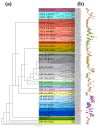Overexpression of TgERF1, a Transcription Factor from Tectona grandis, Increases Tolerance to Drought and Salt Stress in Tobacco
- PMID: 36835560
- PMCID: PMC9961280
- DOI: 10.3390/ijms24044149
Overexpression of TgERF1, a Transcription Factor from Tectona grandis, Increases Tolerance to Drought and Salt Stress in Tobacco
Abstract
Teak (Tectona grandis) is one of the most important wood sources, and it is cultivated in tropical regions with a significant market around the world. Abiotic stresses are an increasingly common and worrying environmental phenomenon because it causes production losses in both agriculture and forestry. Plants adapt to these stress conditions by activation or repression of specific genes, and they synthesize numerous stress proteins to maintain their cellular function. For example, APETALA2/ethylene response factor (AP2/ERF) was found to be involved in stress signal transduction. A search in the teak transcriptome database identified an AP2/ERF gene named TgERF1 with a key AP2/ERF domain. We then verified that the TgERF1 expression is rapidly induced by Polyethylene Glycol (PEG), NaCl, and exogenous phytohormone treatments, suggesting a potential role in drought and salt stress tolerance in teak. The full-length coding sequence of TgERF1 gene was isolated from teak young stems, characterized, cloned, and constitutively overexpressed in tobacco plants. In transgenic tobacco plants, the overexpressed TgERF1 protein was localized exclusively in the cell nucleus, as expected for a transcription factor. Furthermore, functional characterization of TgERF1 provided evidence that TgERF1 is a promising candidate gene to be used as selective marker on plant breeding intending to improve plant stress tolerance.
Keywords: AP2/ERF family; Tectona grandis; drought stress; salt stress; tropical tree.
Conflict of interest statement
The authors declare no conflict of interest.
Figures













Similar articles
-
LchERF, a novel ethylene-responsive transcription factor from Lycium chinense, confers salt tolerance in transgenic tobacco.Plant Cell Rep. 2014 Dec;33(12):2033-45. doi: 10.1007/s00299-014-1678-4. Epub 2014 Sep 3. Plant Cell Rep. 2014. PMID: 25182480
-
Overexpression of the Tectona grandis TgNAC01 regulates growth, leaf senescence and confer salt stress tolerance in transgenic tobacco plants.PeerJ. 2022 Mar 3;10:e13039. doi: 10.7717/peerj.13039. eCollection 2022. PeerJ. 2022. PMID: 35261823 Free PMC article.
-
An AP2/ERF gene, IbRAP2-12, from sweetpotato is involved in salt and drought tolerance in transgenic Arabidopsis.Plant Sci. 2019 Apr;281:19-30. doi: 10.1016/j.plantsci.2019.01.009. Epub 2019 Jan 12. Plant Sci. 2019. PMID: 30824052
-
Genome-wide analysis of AP2/ERF family genes from Lotus corniculatus shows LcERF054 enhances salt tolerance.Funct Integr Genomics. 2014 Sep;14(3):453-66. doi: 10.1007/s10142-014-0372-5. Epub 2014 Apr 29. Funct Integr Genomics. 2014. PMID: 24777608
-
Isolation and molecular characterization of GmERF7, a soybean ethylene-response factor that increases salt stress tolerance in tobacco.Gene. 2013 Jan 15;513(1):174-83. doi: 10.1016/j.gene.2012.10.018. Epub 2012 Oct 27. Gene. 2013. PMID: 23111158
Cited by
-
Identification and analysis of differentially expressed trihelix genes in maize (Zea mays) under abiotic stresses.PeerJ. 2023 May 1;11:e15312. doi: 10.7717/peerj.15312. eCollection 2023. PeerJ. 2023. PMID: 37151290 Free PMC article.
-
Green synthesis of a dual-functional sulfur nanofertilizer to promote growth and enhance salt stress resilience in faba bean.BMC Plant Biol. 2024 Jun 26;24(1):607. doi: 10.1186/s12870-024-05270-7. BMC Plant Biol. 2024. PMID: 38926889 Free PMC article.
-
Transcript-wide identification and expression pattern analysis to comprehend the roles of AP2/ERF genes under development and abiotic stress in Trichosanthes kirilowii.BMC Plant Biol. 2023 Jul 10;23(1):354. doi: 10.1186/s12870-023-04362-0. BMC Plant Biol. 2023. PMID: 37430217 Free PMC article.
-
Oil Palm AP2 Subfamily Gene EgAP2.25 Improves Salt Stress Tolerance in Transgenic Tobacco Plants.Int J Mol Sci. 2024 May 22;25(11):5621. doi: 10.3390/ijms25115621. Int J Mol Sci. 2024. PMID: 38891808 Free PMC article.
-
SNAC3 Transcription Factor Enhances Arsenic Stress Tolerance and Grain Yield in Rice (Oryza sativa L.) through Regulating Physio-Biochemical Mechanisms, Stress-Responsive Genes, and Cryptochrome 1b.Plants (Basel). 2023 Jul 23;12(14):2731. doi: 10.3390/plants12142731. Plants (Basel). 2023. PMID: 37514345 Free PMC article.
References
-
- Zhang B., Su L., Hu B., Li L. Expression of AhDREB1, an AP2/ERF Transcription Factor Gene from Peanut, Is Affected by Histone Acetylation and Increases Abscisic Acid Sensitivity and Tolerance to Osmotic Stress in Arabidopsis. Int. J. Mol. Sci. 2018;19:1441. doi: 10.3390/ijms19051441. - DOI - PMC - PubMed
-
- Fujita M., Fujita Y., Noutoshi Y., Takahashi F., Narusaka Y., Yamaguchi-Shinozaki K. Crosstalk between abiotic and biotic stress responses: A current view from the points of convergence in the stress signaling networks. Curr. Opin. Plant Biol. 2006;9:436–442. doi: 10.1016/j.pbi.2006.05.014. - DOI - PubMed
-
- Cheng M.C., Liao P.M., Kuo W.W., Lin T.P. The Arabidopsis ETHYLENE RESPONSE FACTOR1 Regulates abiotic stress-responsive gene expression by binding to different cis-acting elements in response to different stress signals. Plant Physiol. 2013;162:1566–1582. doi: 10.1104/pp.113.221911. - DOI - PMC - PubMed
MeSH terms
Substances
Grants and funding
LinkOut - more resources
Full Text Sources
Research Materials

